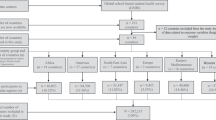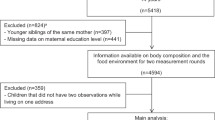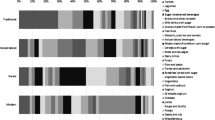Abstract
Background/objectives:
To facilitate the development of practical public health advice targeted at childhood obesity (OB) prevention and make the intervention programs more effective, one has to promote the most protective habits and limit or modify the risk factors. The objective of the present study was to recognize the most important dietary and physical activity habits, sedentary behaviors, plus parental influences that are associated with childhood overweight (OW) and OB, in a nationwide, cross-sectional sample of Greek school children.
Subjects/methods:
Data from 4552 children (10–12 years old) and 2225 of their parents were included in the analysis. Direct anthropometric measurements and information on dietary and physical activity habits was obtained from the children, as was information on parental self-reported anthropometric values, perceptions and family environment information.
Results:
Multiple logistic regression analysis revealed that the most important predictors of childhood OW/OB were breakfast frequency (odds ratio (OR): 0.95; 95% confidence interval (CI): 0.92–0.97), daily number of meals and snacks (OR: 0.92; 95% CI: 0.87–0.97), the frequency of family meals (OR: 0.86; 95% CI: 0.76–0.99), having both a TV and a PC/video game player in the bedroom (OR: 1.41; 95% CI: 1.18–1.69) and study hours on weekdays (OR: 1.07; 95% CI: 1.02–1.13). In the case of parents, mothers' age (OR: 0.91; 95% CI: 0.86–0.97), maternal (OR: 1.13; 95% CI: 1.06–1.21) and paternal (OR: 1.08; 95% CI: 1.02–1.15) body mass index (BMI) and children's BMI misclassification (OR: 6.22; 95% CI: 3.62–10.71) were significant predictors of children’s OW/OB.
Conclusions:
These findings could guide future investigations or public health initiatives to prevent and confront the childhood OB epidemic more efficiently.
This is a preview of subscription content, access via your institution
Access options
Subscribe to this journal
Receive 12 print issues and online access
$259.00 per year
only $21.58 per issue
Buy this article
- Purchase on Springer Link
- Instant access to full article PDF
Prices may be subject to local taxes which are calculated during checkout
Similar content being viewed by others
References
Ogden CL, Caroll MD, Curtin LR, Lamb MM, Flegal KM . Prevalence of high body mass index in US children and adolescents, 2007–2008. JAMA 2010; 303: 242–249.
Lobstein T, Frelut ML . Prevalence of overweight among children in Europe. Obes Rev 2003; 4: 195–200.
Binkin N, Fontana G, Lamberti A, Cattaneo C, Baglio G, Perra A, Spinelli A . A national survey of the prevalence of childhood overweight and obesity in Italy. Obes Rev 2010; 11: 2–10.
Farajian P, Risvas G, Karasouli K, Pounis GD, Kastorini CM, Papangiotakos DB et al. Very high childhood obesity prevalence and low adherence rates to the Mediterranean diet in Greek children: The GRECO study. Atherosclerosis 2011; 217: 525–530.
Deshmukh-Taskar P, Nicklas TA, Morales M, Yang SJ, Zakeri I, Berenson GS . Tracking of overweight status from childhood to young adulthood: the Bogalusa Heart Study. Eur J Clin Nutr 2006; 60: 48–57.
Freedman DS, Dietz WH, Srinivasan SR, Berenson GS . The relation of overweight to cardiovascular risk factors among children and adolescents: the Bogalusa Heart Study. Pediatrics 1999; 103: 1175–1182.
Deshmukh-Taskar PR, Nicklas TA, O’Neil CE, Keast DR, Radcliffe JD, Cho S . The relationship of breakfast skipping and type of breakfast consumption with nutrient intake and weight status in children and adolescents: the National Health and Nutrition Examination Survey 1999–2006. J Am Diet Assoc 2010; 110: 869–878.
Kontogianni MD, Farmaki AE, Vidra N, Sofrona S, Magkanari F, Yannakoulia M . Associations between lifestyle patterns and body mass index in a sample of Greek children and adolescents. J Am Diet Assoc 2010; 110: 215–221.
Nicklas TA, Baranowski T, Cullen KW, Berenson G . Eating patterns, dietary quality and obesity. J Am Coll Nutr 2001; 20: 599–608.
Wong SL, Leatherdale ST . Association between sedentary behavior, physical activity, and obesity: inactivity among active kids. Prev Chronic Dis 2009; 6: A26.
Chaput JP, Lambert M, Gray-Donald K, McGrath JJ, Tremblay MS, O'Loughlin J et al. Short sleep duration is independently associated with overweight and obesity in Quebec children. Can J Public Health 2011; 102: 369–374.
Hense S, Pohlabeln H, De Henauw S, Eiben G, Molnar D, Moreno LA et al. Sleep duration and overweight in European children: is the association modified by geographic region? Sleep 2011; 34: 885–890.
Adamo KB, Brett KE . Parental perceptions and childhood dietary quality. Matern Child Health J 2013; 18: 978–995.
Manios Y, Kondaki K, Kourlaba G, Vasilopoulou E, Grammatikiaki E . Maternal perceptions of their child's weight status: the GENESIS study. Publ Health Nutr 2008; 12: 1099–1105.
Farajian P, Panagiotakos DB, Risvas G, Karasouli K, Bountziouka V, Voutzourakis N et al. Socioeconomic and demographic determinants of childhood obesity prevalence in Greece: the GRECO Study. Publ Health Nutr 2013; 16: 240–247.
Cole TJ, Bellizzi MC, Flegal KM, Dietz WH . Establishing a standard definition for child overweight and obesity worldwide: international survey. BMJ 2000; 320: 1240–1243.
Farajian P, Karasouli K, Risvas G, Panagiotakos DB, Zampelas A . Repeatability and validity of a food frequency and dietary habits questionnaire in children. Circulation 2009; 119: e288.
Kowalski KC, Crocker PR, Faulkner RA . Validation of the Physical Activity Questionnaire for older children. Pediatr Exerc Sci 1997; 9: 174–186.
US Department of Agriculture and US Department of Health and Human Services. Dietary Guidelines for Americans, 7th edn. US Government Printing Office: Washington, DC, USA, 2010.
World Health Organization Obesity: preventing and managing the global epidemic. Report of a WHO Consultation on Obesity; Technical Report Series No. 98.1, Geneva, Switzerland, 1997.
Panagiotakos DB, Pitsavos C, Arvaniti F, Stefanadis C . Adherence to the Mediterranean food pattern predicts the prevalence of hypertension, hypercholesterolemia, diabetes and obesity, among healthy adults; the accuracy of the MedDietScore. Prev Med 2005; 44: 335–340.
Elder JP, Ayala GX, Harris S . Theories and intervention approaches to health-behavior change in primary care. Am J Prev Med 1999; 17: 275–284.
Grydeland M, Bergh IH, Bjelland M, Lien N, Andersen LF, Ommundsen Y et al. Correlates of weight status among Norwegian 11-years-olds: the HEIA study. BMC Public Health 2012; 12: 1053.
Moschonis G, Kalliora AC, Costarelli V, Papandreou C, Koutoukidis D, Lionis C et al. Identification of lifestyle patterns associated with obesity and fat mass in children: the Healthy Growth study. Publ Health Nutr 2013; 26: 1–11.
Toschke AM, Kuchenhoff H, Koletzko B, Von Kries R . Meal frequency and childhood obesity. Obes Res 2005; 13: 1932–1938.
Koletzko B, Toschke AM . Meal pattern and frequencies: do they affect body weight in children and adolescents? Crit Rev Food Sci Nutr 2010; 50: 100–105.
Hammons AJ, Fiese BH . Is frequency of shared family meals related to the nutritional health of children and adolescents. Pediatrics 2011; 127: e1565–e1574.
Scaglioni S, Salvioni M, Galimberti C . Influence of parental attitudes in the development of children eating behavior. Br J Nutr 2008; 99: S22–S25.
Dupuy M, Godeau E, Vignes C, Ahluwalia N . Socio-demographic and lifestyle factors associated with overweight in a representative sample of 11-15 year olds in France: results from the WHO-Collaborative Health Behaviour in School-aged Children (HBSC) cross-sectional study. BMC Public Health 2011; 11: 442.
Janssen I, Katzmarzyk PT, Boyce WF, Vereecken C, Mulvihill C, Roberts C et al. Comparison of overweight and obesity prevalence in school-aged youth from 34 countries and their relationships with physical activity and dietary patterns. Obes Rev 2005; 6: 123–132.
Wareham NJ, Van Sluijs EM, Ekelund U . Physical activity and obesity prevention: a review of the current evidence. Proc Nutr Soc 2005; 64: 229–247.
Van Der Horst K, Paw MJ, Twisk JW, Van Mechelen W . A brief review on correlates of physical activity and sedentariness in youth. Med Sci Sports Exerc 2007; 39: 1241–1250.
Cameron AJ, van Stralen MM, Brug J, Salmon J, Bere E, Chinapaw MJ et al. Television in the bedroom and increased body weight: potential explanations for their relationship among European schoolchildren. Pediatr Obes 2013; 8: 130–141.
Manios Y, Angelopoulos PD, Kourlaba G, Kolotourou M, Grammatikaki E, Cook TL et al. Prevalence of obesity and body mass index correlates in a representative sample of Cretan school children. Int J Ped Obesity 2010; 6: 135–141.
Seagle HM, Strain GW, Makris A, Reeves RS . Position of the American Dietetic Association: weight management. J Am Diet Assoc 2009; 109: 330–346.
Maynard LM, Galuska DA, Blanck HM, Serdula MK . Mothers’ perceptions of weight status of children. Pediatrics 2003; 111: 1226–1231.
Rietmeijer-Mentink M, Paulis WD, van Middelkoop M, Bindels PJE, van der Wouden JC . Difference between parental perception and actual weight status of children: a systematic review. Matern Child Nutr 2013; 9: 3–22.
Supreme Scientific Health Council, Ministry of Health and Welfare of Greece. Dietary guidelines for adults in Greece. Arch Hellenic Med 1999; 16: 516–524.
Spencer EA, Appleby PN, Davey GK, Key TJ . Validity of self-reported height and weight in 4808 EPIC-Oxford participants. Public Health Nutr 2002; 5: 561–565.
Acknowledgements
Funding for the study was provided by the General Secretariat of Consumers-Greek Ministry of Development, Hellenic Association of Food and Beverage Companies, Coca Cola Hellas, Coca Cola Hellenic Bottling Company, Cereal Partners Hellas, FAGE SA, Unilever Hellas, Nestle Hellas and Kraft Foods Hellas. This research has also been cofinanced by the European Union (European Social Fund—ESF) and Greek national funds through the Operational Program ‘Education and Lifelong Learning’ of the National Strategic Reference Framework (NSRF)—Research Funding Program: Heraclitus II. Investing in knowledge society through the European Social Fund.
AUTHOR CONTRIBUTIONS
PF, DBP, GR and AZ were responsible for the study design and the supervision of the field study. DBP and PF were responsible for the statistical analysis. PF, DBP, OM, GR and AZ were responsible for the interpretation of the data. All authors carried out data management, contributed to database preparation and participated in writing the submitted manuscript.
Author information
Authors and Affiliations
Corresponding author
Ethics declarations
Competing interests
The authors declare no conflict of interest.
Rights and permissions
About this article
Cite this article
Farajian, P., Panagiotakos, D., Risvas, G. et al. Hierarchical analysis of dietary, lifestyle and family environment risk factors for childhood obesity: the GRECO study. Eur J Clin Nutr 68, 1107–1112 (2014). https://doi.org/10.1038/ejcn.2014.89
Received:
Accepted:
Published:
Issue Date:
DOI: https://doi.org/10.1038/ejcn.2014.89
This article is cited by
-
Associations between the home environment and childhood weight change: a cross-lagged panel analysis
International Journal of Obesity (2022)
-
Early childhood body mass index trajectory and overweight/obesity risk differed by maternal weight status
European Journal of Clinical Nutrition (2022)
-
The impact of maternal influences on childhood obesity
Scientific Reports (2022)
-
Prevalence and trends of underweight in European children and adolescents: a systematic review and meta-analysis
European Journal of Nutrition (2021)
-
Association of parental body mass index (BMI) with child’s health behaviors and child’s BMI depend on child’s age
BMC Obesity (2019)



